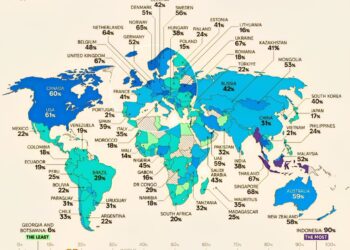Select Language:
Top 50 Global Economies with the Fastest GDP Growth in 2025

-
Ireland – 9.1% Growth
Ireland continues to lead the global surge, driven by technological investments and a thriving export sector. The country’s policies favor innovation, attracting multinational companies that bolster its economic metrics. -
India – 6.6% Growth
India’s economy accelerates under its digital transformation initiatives, infrastructure development, and a booming service sector. The nation’s demographic advantage remains a key factor in its robust economic expansion. -
Vietnam – 6.5% Growth
Vietnam’s manufacturing and export sectors flourish, thanks to increased foreign direct investment and resilient supply chains. The country also benefits from its strategic location in Southeast Asia. -
Kazakhstan – 5.9% Growth
Kazakhstan’s diversified economy gains momentum, with significant contributions from energy exports, mining, and agriculture sectors, supported by government reforms aimed at attracting foreign capital. -
Philippines – 5.4% Growth
The Philippines’ service industry, especially outsourcing and call centers, continues to propel economic growth. Remittances from overseas Filipino workers also fuel domestic spending. -
Indonesia – 4.9% Growth
Indonesia’s expansive domestic market and infrastructure investments propel its economy. Digital economy expansion and resource development contribute substantially to this growth. -
UAE – 4.8% Growth
The United Arab Emirates diversifies away from oil reliance, boosting sectors like tourism, logistics, and finance. Strategic mega-developments and renewable energy projects bolster the outlook. -
China – 4.8% Growth
China resumes steady growth with a focus on technological innovation and green energy. The government’s policy shift towards high-tech industries supports this momentum. -
Malaysia – 4.5% Growth
Malaysia benefits from its electronics manufacturing and export sectors. Enhanced bilateral trade agreements and investments stimulate economic activity. -
Argentina – 4.5% Growth
Argentina’s economic reform efforts and agricultural exports are key growth drivers amid regional economic fluctuations. -
Egypt – 4.3% Growth
Structural reforms, infrastructure upgrades, and a tourism revival contribute to Egypt’s economic acceleration. -
Saudi Arabia – 4.0% Growth
Saudi Arabia’s Vision 2030 initiatives stimulate non-oil sectors, including entertainment, tourism, and renewable energy. -
Bangladesh – 3.8% Growth
The country’s garment industry and remittances support consistent economic expansion, alongside government investments in infrastructure. -
Taiwan – 3.7% Growth
Taiwan’s tech manufacturing and semiconductor industries remain central to its resilient economy. -
Turkey – 3.5% Growth
Structural reforms and a rebound in tourism sectors help Turkey maintain a positive economic trajectory. -
Poland – 3.2% Growth
The country benefits from a robust labor market, EU investments, and strong manufacturing sectors. -
Spain – 2.9% Growth
Cultural tourism, renewable energy initiatives, and a recovering service sector underpin Spain’s growth pattern. -
Peru – 2.9% Growth
Mineral exports and infrastructure projects continue to energize Peru’s economic prospects. -
Pakistan – 2.7% Growth
Reforms in finance and energy sectors and infrastructural development aid Pakistan’s steady growth. -
Israel – 2.5% Growth
Innovation, biotech, and tech startups drive Israel’s economic vitality.
Continued Leadership Among the Global Economies (2025)
-
Colombia – 2.5% | 22. Chile – 2.5% | 23. Hong Kong – 2.4%
South American economies, alongside Hong Kong, see incremental growth driven by commodities and trade. -
Brazil – 2.4%
Brazil’s agriculture and mining sectors remain vital, with recent reforms supporting economic stability. -
Czechia – 2.3%
European manufacturing and EU integration fuel Czechia’s steady climb. -
Singapore – 2.2%
Singapore’s finance and logistics sectors are resilient amid global shifts. -
United States – 2.0%
The US economy maintains moderate growth with innovations in tech, healthcare, and green energy. -
Thailand & Portugal – 2.0% & 1.9%
Both countries benefit from tourism, manufacturing, and strategic investments. -
Denmark & Australia – 1.8%
Sustainability initiatives and natural resources support their growth. -
Netherlands & United Kingdom – 1.4% & 1.3%
Strong trade links and technological investments help these European nations retain their economic stature.
The Global Economic Outlook: Smaller but Resilient Powers
-
Norway & Canada – 1.2%
Recovered from previous fluctuations thanks to energy exports and natural resource management. -
South Africa & Japan – 1.1%
Structural reforms and technology sectors facilitate modest growth, despite challenges. -
Belgium & Romania – 1.1% & 1.0%
European nations focusing on innovation and manufacturing. -
Mexico & Switzerland – 1.0%
Trade agreements and financial hubs underpin economic stability. -
South Korea, Sweden & France – 0.9% – 0.7%
Advanced economies pivot toward sustainable practices and technological innovation. -
Russia & Iran – 0.6%
Persisting geopolitical factors temper growth, but strategic resource exports sustain their economies. -
Italy & Finland – 0.5%
Recovery efforts in tourism and technology sectors are underway. -
Austria & Germany – 0.3% & 0.5%
European powerhouses stabilize with ongoing structural reforms and green initiatives.
The Global Economic Landscape of 2025
As 2025 unfolds, the leading growth nations are primarily from Asia, with emerging markets still holding strong in Africa and Latin America. The shift toward sustainable development, technological innovation, and geopolitical stability are central themes shaping this year’s economic landscape.
Note: Data sourced from the International Monetary Fund’s October 2025 report.







